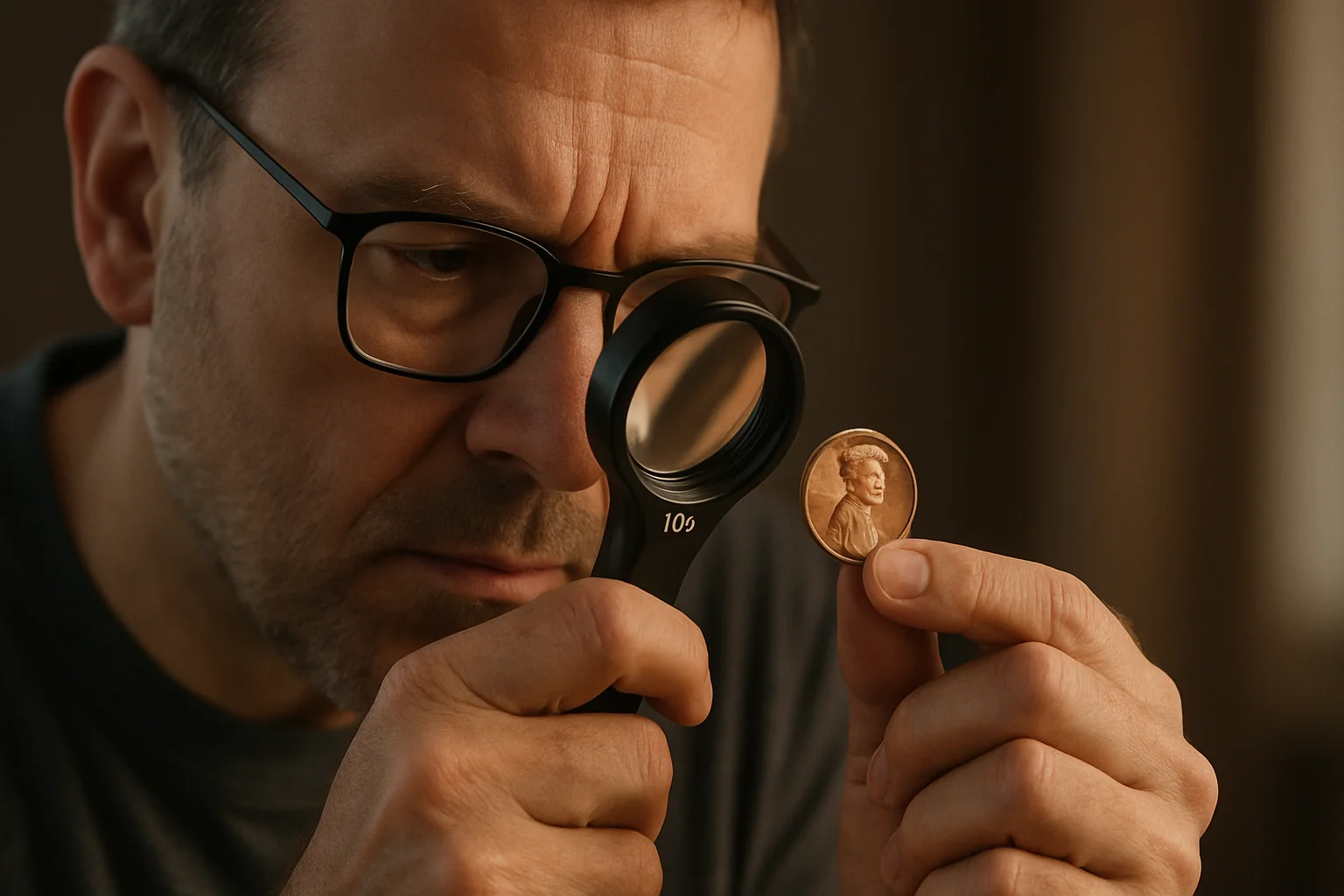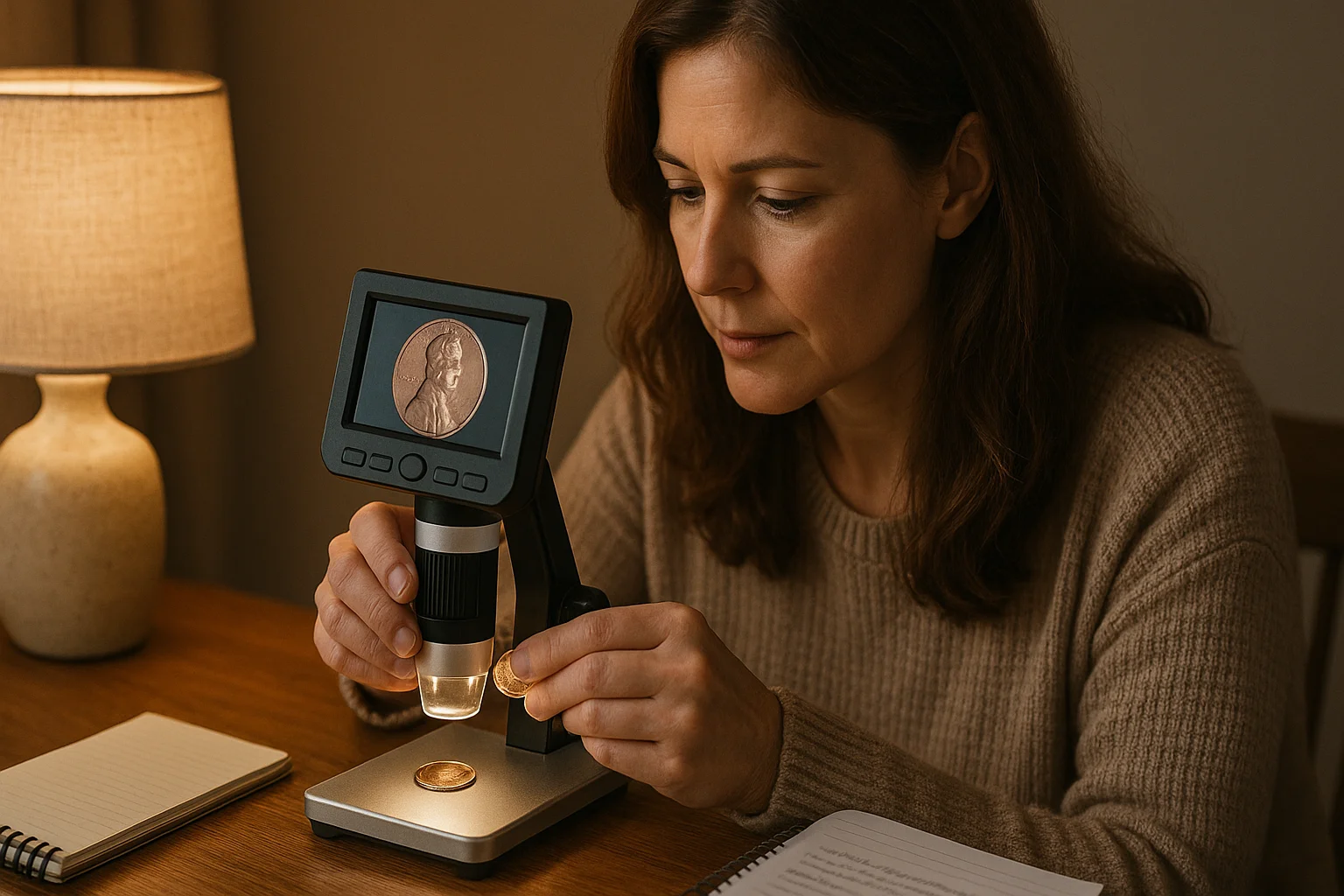If you’ve ever spotted what looks like a shadowy second image on a penny — like doubled letters in LIBERTY or a blurry second date — you may have stumbled onto a double die penny. But before you imagine dollar signs, there’s one important question: is it a true minting error, or just damage from circulation?
Double die pennies are some of the most intriguing coins in U.S. history — with the legendary 1955 issue at the top of the list. That coin, with its dramatic doubling on the obverse, was so bold it was visible to the naked eye — and yet it circulated for decades before people realized what they had.
Today, that same coin can sell for hundreds or even thousands of dollars in good condition. But most other errors? They are far more subtle, and if you rely on just your eyes or hearsay from online forums, you are likely to miss them — or mistake everyday wear for a rare piece. That’s where proper tools come in.
What Is a Double Die, Anyway?
Very simply, a double die is a coin struck by a die (the stamping tool) that has a misalignment in its engraved design. The doubling is part of the die itself — not something that happened after the coin was made. It is a minting error, not damage from use. But be careful: not all “doubling” is the real deal. A coin that looks doubled might actually show what’s called machine doubling, a much more common and far less valuable defect.
Why You Need More Than Just Good Eyes
To truly evaluate a suspected error, especially something like a double die penny, you need three key things: magnification, proper lighting, and comparison tools. These help you distinguish true die doubling from optical illusions, smudges, scratches, or mechanical flattening.
Let’s break down what really helps:
Magnifying Loupes
When you’re trying to identify something as subtle as a double die penny, a quality magnifying loupe is your best friend. It’s the simplest tool with the biggest impact — and you don’t need to spend a fortune to get a good one.
- What to look for: A magnification level between ×10 and ×20 is ideal. Glass lenses offer clearer images than plastic. Built-in LED lighting is a plus.
- Pro tip: Choose clarity over power. A sharp ×10 loupe will serve you better than a blurry ×30.
- Good picks: Brands like BelOMO and Bausch & Lomb are trusted by both jewelers and seasoned collectors.
- Fun fact: Many pros carry their loupe on a keychain — ready to inspect change on the go.

Digital Microscopes
If you want to document what you find — or simply get a second opinion — digital microscopes make the process easier. These are especially handy if you are comparing your coin to known double die examples from auction sites or online databases.
- Great for capturing detailed images and video of your coin.
- Connectivity: Can be linked to your smartphone, tablet, or computer.
- Research help: Extremely helpful when comparing your coin to verified catalog examples.
- Price range: $30 to $150 depending on resolution and features.
- Why they matter: They let you zoom in on small elements like the curl of a letter or a doubled serif — things impossible to see with the naked eye.
Lighting: The Most Underrated Tool
Collectors often underestimate how important lighting is. Even the best loupe or microscope can fail you if the coin isn’t properly lit. The right lighting reveals texture, depth, and subtle doubling that poor lighting can completely hide.
- Lighting technique: Use soft, angled lighting — never direct harsh light. Overexposure flattens the relief and makes doubling hard to detect.
- Best tools: Desk lamps with flexible arms or ring lights built into microscopes work best.
- Pro tip: Tilt the coin and the light source slowly. True doubling will often “catch” the light at certain angles, while damage will look flat or inconsistent.

Look Twice: How to Tell a Double Die Penny from Regular Damage
So you’ve got your loupe. You’ve set up proper lighting. Now comes the tricky part: looking at a coin and figuring out if what you’re seeing is a true double die penny… or just a misleading mark.
Let’s be clear — not everything that looks doubled is actually a mint error. In fact, most of the coins that appear suspicious turn out to be completely ordinary. That’s why experienced collectors train their eyes through practice, comparisons, and reliable sources. Because doubling can be subtle, and damage can be deceptive.
The good news? You don’t need to be a lifelong numismatist to develop this skill – нou just need to know what to look for (and what to ignore).
Is It an Error or Not? Here’s a Quick Guide
Below is a comparison table to help you sort fact from fiction. These are some of the most commonly misread features on pennies, and what they actually mean:
| Visual Sign | Is It an Error? | Explanation | Fun Fact |
| Repeated letters in LIBERTY | Double Die | Caused by a doubled image engraved into the die | Most famous example: 1955 double die cent |
| Blurry or smeared letter | No | Usually a “strike through grease” — metal flow issue | Surprisingly common, even in modern coins |
| Strong shadow-like design doubling | No | Likely post-mint damage or strike bounce | Often mistaken for valuable doubling but isn’t worth more |
| Doubled rim or outer edge | Sometimes | May result from off-center strike or misalignment | Must be verified against real examples from auction or catalogs |
Look Closer: The Key to Spotting Errors
True double die errors always affect the design elements — that means letters, numbers, facial features, and other engraved parts of the coin. You’ll often see clear doubling on inscriptions like LIBERTY, IN GOD WE TRUST, or the date.
Random marks on blank spaces? Probably just wear, not a minting flaw.
That’s why you should always compare your find to trusted photos from reliable databases. Three of the best online resources for this include:
- PCGS CoinFacts (Professional Coin Grading Service)
- NGC
- Variety Vista (great for side-by-side images of double dies)
Another quick hack: rotate your coin slowly under light. If the doubling “flickers” or looks inconsistent depending on the angle, it’s likely just a surface dent or reflection. True doubling remains fixed and clean under magnification.
Spotting the difference takes time — even professionals sometimes need second opinions. But as your eye sharpens and your confidence grows, you’ll get faster at separating the keepers from the clutter.
Ready, Set, Store: How to Verify and Protect Your Finds
So you’ve zoomed in, lit it just right, and you’re pretty sure you’ve got a double die penny on your hands. Now what?
Before you start dreaming of dollar signs, it’s time to verify, document, and store your discovery like a true collector. Because even the most exciting finds lose value fast if they’re mishandled — or misidentified.
Start with the Coin ID Scanner
One of the easiest and most beginner-friendly ways to get started is with the Coin ID Scanner app. It won’t confirm an error — that still takes human judgment and expert comparison — but it’s a smart, fast way to:
- Catalog your coin with date, mintmark, and photos
- Identify and compare it against a database of known coins and find historical background and other features
- Track your finds in one place
Think of it as your digital coin journal. It’s especially useful if you’re just starting out and aren’t ready to dive into pro-level forums or grading services. Plus, it saves you the headache of wondering “Wait… did I already check this penny last week?”
Store It Like a Pro (Not a Rookie)
Let’s make this simple: never clean a coin. Seriously. Not with toothpaste, not with vinegar, not with anything. Cleaning can destroy fine details and destroy value — even with a rare error.
Here’s what to do instead:
- Use 2×2 cardboard or plastic holders (they’re cheap, safe, and stackable)
- Label each one with the year, mint mark, and suspected error
- Take photos, especially through your microscope
- Keep a digital log — a simple Excel sheet or phone Notes app works great
You are not just collecting coins; you’re building a personal archive of your discoveries. Treat it like a jewel — because one day, it might be.
Real Double Die Pennies Worth Watching For
Need proof that tiny details can lead to big rewards? These are real, confirmed double die varieties that have made collectors’ jaws drop:
| Year and Type | Error Details | Value Range |
| 1955 DDO | Strong doubling in LIBERTY and IN GOD WE TRUST | $800–$2,000+ |
| 1969-S DDO | Dramatic doubling on all obverse text | $35,000+ (MS65) |
| 1972 DDO Type 1 | Clear doubling on LIBERTY and date | $200–$800 |
| 1983 DDO | Subtle doubling, popular among variety collectors | $100–$300 |
And yes — these coins still turn up from time to time in pocket change, estate sales, or forgotten coffee tins. You just need a sharp eye and a bit of luck.
It All Starts with a Closer Look
You don’t need a Ph.D. in numismatics to spot a valuable coin. What you do need is patience, curiosity, and the right tools. With nothing more than a loupe, good lighting, and a trusty app like Coin ID Scanner, you’re well on your way to building your skills — and maybe finding that once-in-a-lifetime penny. Keep checking your change. Because sometimes, the next great jewel is just a flicker of doubling away.




